Digital art: a means to experience the augmented world
By Psyche Cho Mapped out under the umbrella theme of ‘Cross’ this year, the festival, which runs through November 20 in Taipei’s Bopiliao Historic Block, aims to examine the phenomenon of crossing borders, a procedure of stirring, changing, recombining and creating new objects, in digital space. “Why do we digitalize things?” reflected Cheng Mei-ya, Curator of the International Digital Art Exhibition, the most highly-anticipated part of all in the festival. She continued to raise questions like “What aspect of human life has been changed through the development of this material?” Delving into these questions has led her back to the roots of digital art, an art genre which demonstrates concepts through technical means. Thus the exhibition entitled Augmenting the World, which covers five works in the format of acting, parade, animation, and other media, enables people to experience a realm that lies between reality and imagination through interfaces commonly seen in our daily lives. Austrian artist Oliver Hangl’s Taipei Guerilla Walks, a convergence of performance, parade and experimental communication, was carried out November 7 and 13 in Taipei. Participants in the project were given a headset from which they received information from the artist while at the same time blocking out auditory cues from the surrounding environment. They thus experienced two worlds at the same time, one being reality through the visual sense, the other the isolated association among the walkers through the sense of hearing. “It’s an artificial circumstance that is neither reality nor fiction,” said Curator Cheng. She continued by saying this would lead to “an amusing focus between seeing and being seen.” Marching through the Bopiliao area in Wanhua District on November 7, the secret society carried out both pre-scheduled and improvisational activities. As its name suggests, anyone who participates in a guerilla walk should expect great uncertainty. And that is exactly the charm it represents to its launcher. “It’s like (the way) I decide my life,” said Hangl November 10 at the pre-show conference. The event runs for a duration of 3 hours, Hangl said, principally depending on “what the city gives me,” adding that “generally speaking, 60% of the setting should be completed.” As for local participants’ response to the event, the artist said “I think they like it, it’s entertaining, surprising and good,” Hangl noted with a smile. With a background as a theater actor, Hangl’s works fuse elements of performance and action art. Guerilla Walks, for example, integrate simulated scenarios into a reality in which the audience simultaneously Becoming the bank robber If guerilla actions sound just not that thrilling, then try the virtual reality game—robbing a bank. Under the direction of UK-based group Blast Theory, A Machine to See With is a project augmenting the reality as well as a “movie” made on-site which turns the audience into the leading actor. The artist begins by asking the audience to make appointments for a 50-minute screening. Later, they receive instructions via mysterious phone calls at appointed times to meet with partners they have never met before— to rob a bank together. The way it performed was inspired by a line in Jean-Luc Godard’s film Pierrole le Fou—‘my eyes are a machine to see with’, said Nick Tandavanitj, co-founder of the group, during the pre-show conference November 10 in Taipei. “The action is like seeing the city as a film,” Tandavanitj said. But why a bank robbery? “It’s a reaction to the global financial crisis,” answered the artist. “A way to reflect ordinary people’s powerlessness under the capital mechanism,” he added. Reaction from participants varies, as some consider it a very ordinary activity like just walking around and speaking on the phone, whereas some became dramatized themselves and actively got involved in the project, said the artist. Based in the UK, Blast Theory consists of three members—Matt Adams, Ju Row Farr and Tandavanitj. The phone game work was exhibited at the 2010 Sundance Film Festival and at the San Jose Biennial. Real art with low-tech Similarly, the other three static displays in the international exhibition category also seek to attain real artistic value with the aid of low technology. The Tenth Sentiment, created by self-proclaimed device artist Ryota Kuwakubo, is a toy train equipped with LEDs running on N-gauge rail with infra-red transmitters. Placed at spots along the rail are daily commodities such as a light bulb, pencil and rubber ball. The artist employs the leather-silhouette shadow techniques in a simple white surrounding to generate an immersive experience for viewers. No Ghost Just a Shell, a recreation of abandoned anime character Annlee, discusses issues in digital art production including the relaying / collaborative interpretations and related intellectual property issues, says Cheng in the written introduction to the work. Revolutions, an animated work by Jun Yang, is a new work re-developed from his 2005 work Revolutions Come and Revolutions Go. Cheng points out in the written introduction that this work is an animation in three parts that analyzes the mechanism and process of revolutions. Machine in motion The former is an experiment exploring the human mind in depth through the employment of new media and technologies. Creator XOR, a team made up of graduate students from Taipei National University of the Arts, hopes to convey the idea that the spirit remains even though the body perishes. Puppet Experimental Project, on the other hand, is an interactive performance presented by a dancer and a marionette. The digital puppet moves along with classic Liyuan music to interact with a real dancer. Their interaction generates another kind of conversation between reality and the virtual world. Major programs beside the International Digital Art Exhibition and Digital Art Performance Project, are the Digital Art Awards Taipei, the K.T. Creativity Awards, 2011 AnimA, and the International Artist in Residence Exhibition.
Staff Reporter
Photos courtesy of Digital Art Center, Taipei 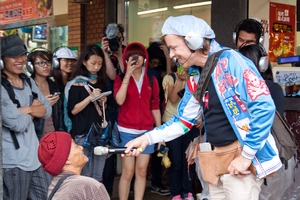 While the ‘digital’ portion of the term ‘digital art’ has gradually siphoned people’s attention away from the ‘art’ aspect in appreciating digital art, calls and action to reverse the trend are springing up all over the place. One effective solution is to adopt a ‘low tech’ approach, as artists are demonstrating this year in the 6th Digital Art Festival Taipei.
While the ‘digital’ portion of the term ‘digital art’ has gradually siphoned people’s attention away from the ‘art’ aspect in appreciating digital art, calls and action to reverse the trend are springing up all over the place. One effective solution is to adopt a ‘low tech’ approach, as artists are demonstrating this year in the 6th Digital Art Festival Taipei. 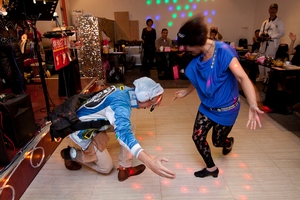 Amoeba roam in Taipei
Amoeba roam in Taipei 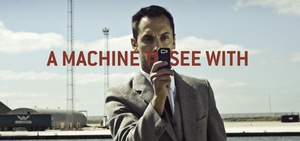 At a brief stop, Hangl led the crowd in singing a song entitled “Amobia-a song from the biological underground,” explaining that “the group roaming through the streets is like an amoeba.” At another point, Hangl twirled round and round with locals in an old-fashioned club and even tried some Taiwan style fortunetelling.
At a brief stop, Hangl led the crowd in singing a song entitled “Amobia-a song from the biological underground,” explaining that “the group roaming through the streets is like an amoeba.” At another point, Hangl twirled round and round with locals in an old-fashioned club and even tried some Taiwan style fortunetelling. The artist said he seeks every possibility in a city and might even venture to “knock on doors and sing a song for people in their flats.”
becomes both performer and viewer. 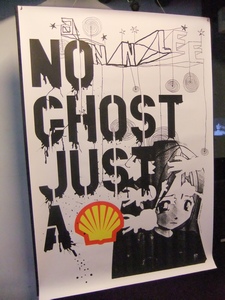 Participants act out a scene as they interact with unknowing onlookers. They create their own movie in their minds for an imaginary audience who may or may not know what is going on, noted Cheng.
Participants act out a scene as they interact with unknowing onlookers. They create their own movie in their minds for an imaginary audience who may or may not know what is going on, noted Cheng. 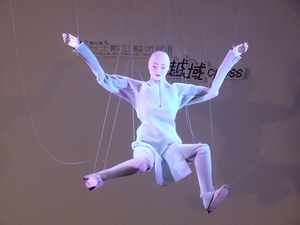 Visitors to the festival will also have a chance to see digital art going on the stage. This year, two shows have been prepared in the Digital Art Performance Project category. One is The Process of Death, which received the 2nd Digital Art Performance Award, and the other is Puppet Experimental Project.
Visitors to the festival will also have a chance to see digital art going on the stage. This year, two shows have been prepared in the Digital Art Performance Project category. One is The Process of Death, which received the 2nd Digital Art Performance Award, and the other is Puppet Experimental Project.

![Taiwan.gov.tw [ open a new window]](/images/egov.png)
